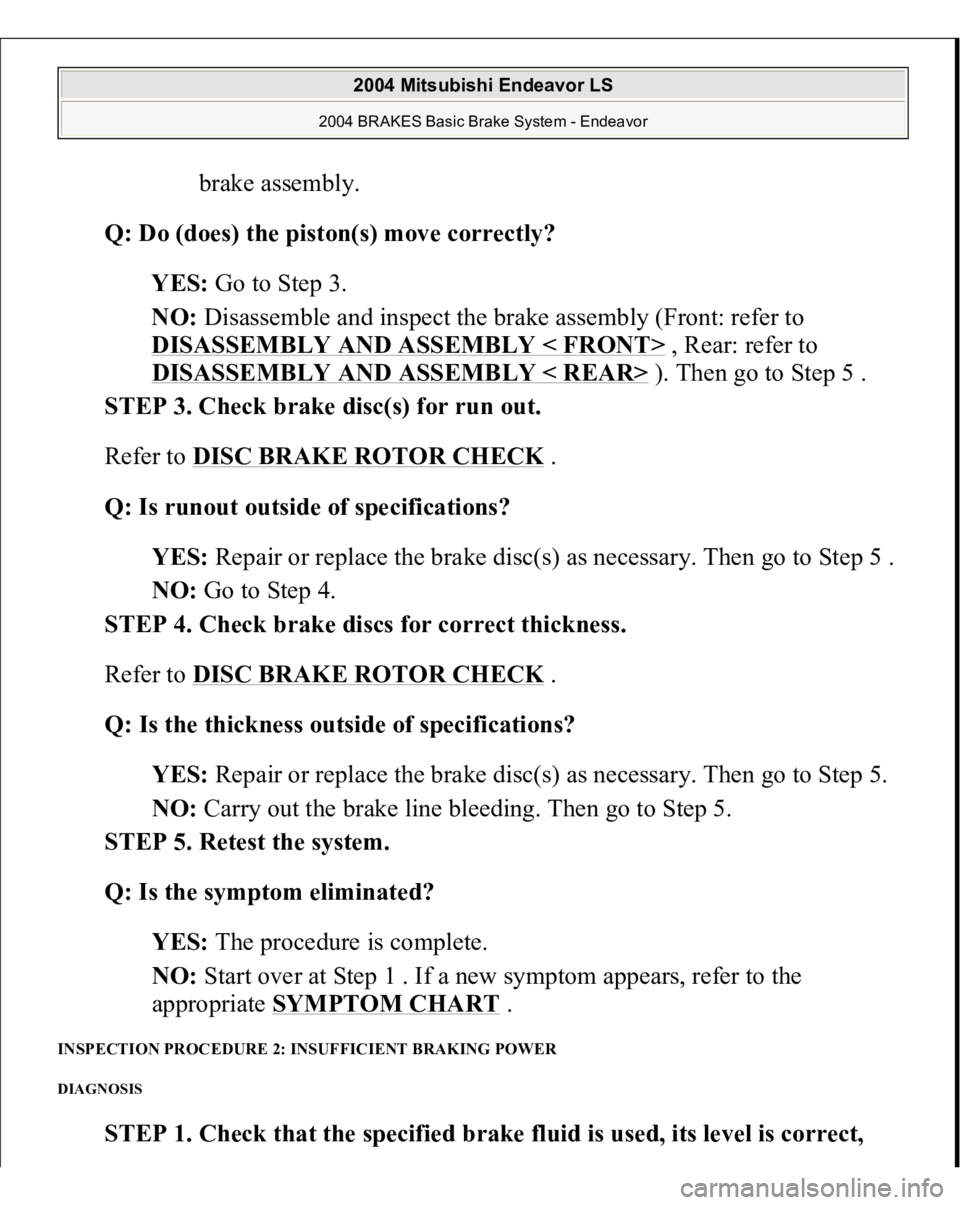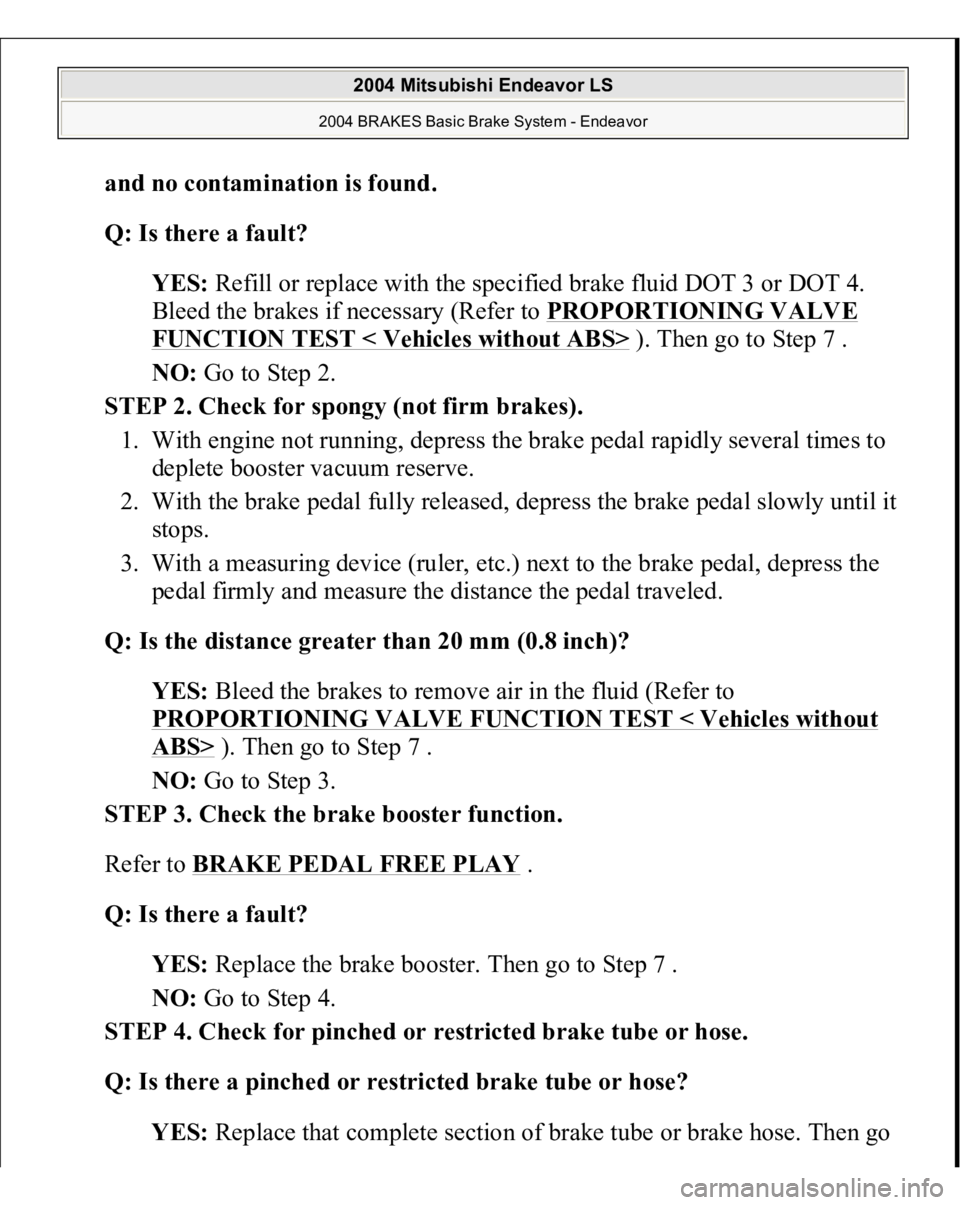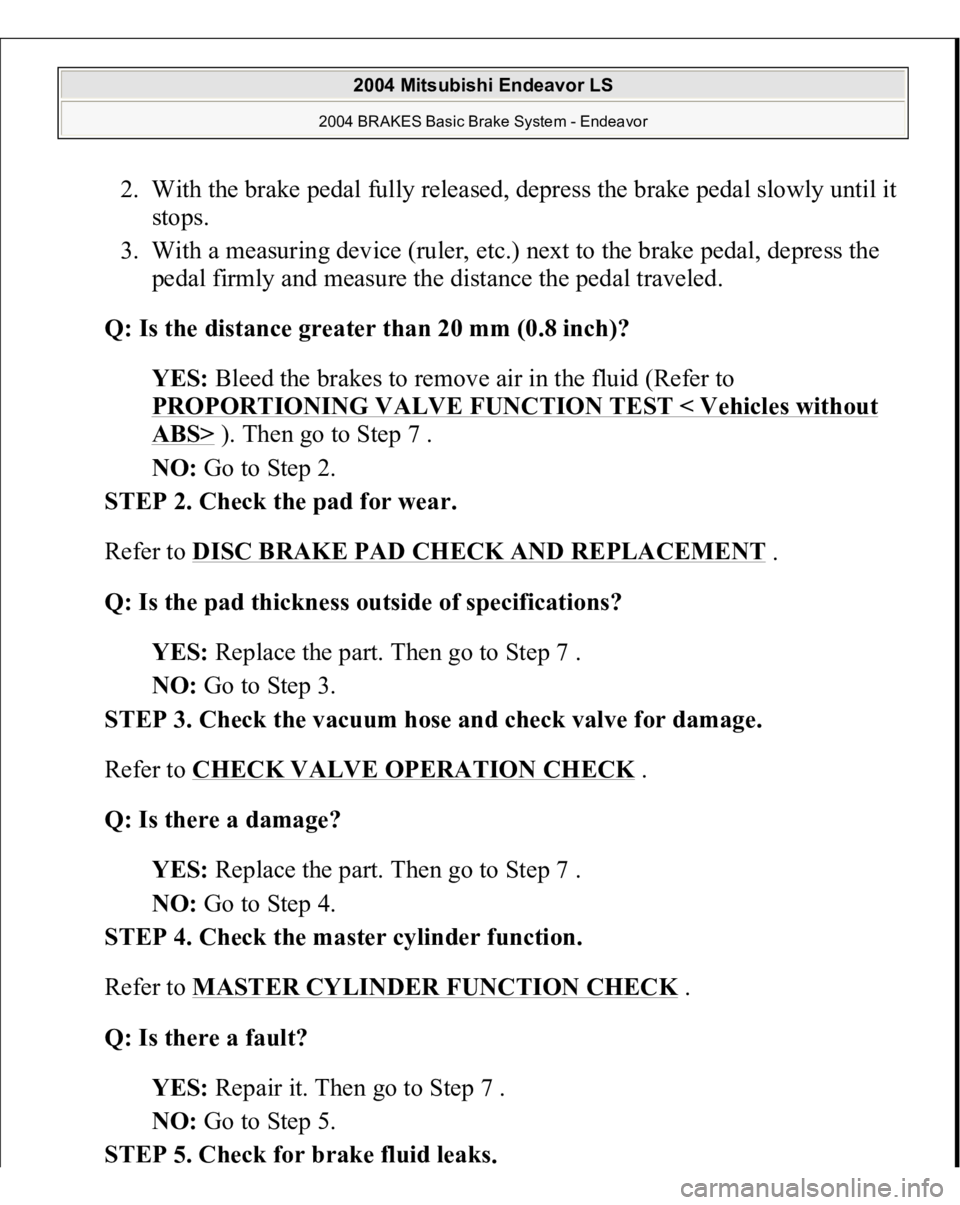Page 470 of 3870
1. Remove the transfer and O-ring < W4A5A >
2. Use a dial gauge to measure the input shaft end play.
3. Remove the torque converter.
4. Remove each bracket.
5. Remove the dipstick.
6. Remove the eye bolt, gaskets and the oil cooler feed tube.
Fig. 13: Measuring Input Shaft End Play
transmission fluid (ATF). If the transaxle body has been damaged,
disassemble and clean the cooler system.
2004 Mitsubishi Endeavor XLS
2004 TRANSMISSION Automatic Transaxle Overhaul - Endeavor
Page 475 of 3870
Fig. 18: Identifying Manual Control Shaft Detent
Courtesy of MITSUBISHI MOTOR SALES OF AMERICA.
12. Disconnect the solenoid valve harness from the valve by undoing the fluid
tem
perature sensor and all the connectors.
2004 Mitsubishi Endeavor XLS
2004 TRANSMISSION Automatic Transaxle Overhaul - Endeavor
Page 590 of 3870
Fig. 136: Installing Valve Body Mounting Bolts
Courtesy of MITSUBISHI MOTOR SALES OF AMERICA.
96. Attach the solenoid valve harness to the valve body by connecting the fluid
tem
perature sensor and all the connectors.
2004 Mitsubishi Endeavor XLS
2004 TRANSMISSION Automatic Transaxle Overhaul - Endeavor
Page 705 of 3870

brake assembly.
Q: Do (does) the piston(s) move correctly?
YES: Go to Step 3.
NO: Disassemble and inspect the brake assembly (Front: refer to
DISASSEMBLY AND ASSEMBLY < FRONT>
, Rear: refer to
DISASSEMBLY AND ASSEMBLY < REAR> ). Then go to Step 5 .
STEP 3. Check brake disc(s) for run out.
Refer to DISC BRAKE ROTOR CHECK
.
Q: Is runout outside of specifications?
YES: Repair or replace the brake disc(s) as necessary. Then go to Step 5 .
NO: Go to Step 4.
STEP 4. Check brake discs for correct thickness.
Refer to DISC BRAKE ROTOR CHECK .
Q: Is the thickness outside of specifications?
YES: Repair or replace the brake disc(s) as necessary. Then go to Step 5.
NO: Carry out the brake line bleeding. Then go to Step 5.
STEP 5. Retest the system.
Q: Is the symptom eliminated?
YES: The procedure is complete.
NO: Start over at Step 1 . If a new symptom appears, refer to the
appropriate SYMPTOM CHART
.
INSPECTION PROCEDURE 2: INSUFFICIENT BRAKING POWER DIAGNOSIS
STEP 1. Check that the specified brake fluid is used, its level is correct,
2004 Mitsubishi Endeavor LS
2004 BRAKES Basic Brake System - Endeavor
Page 706 of 3870

and no contamination is found
.
Q: Is there a fault?
YES: Refill or replace with the specified brake fluid DOT 3 or DOT 4.
Bleed the brakes if necessary (Refer to PROPORTIONING VALVE
FUNCTION TEST < Vehicles without ABS>
). Then go to Step 7 .
NO: Go to Step 2.
STEP 2. Check for spongy (not firm brakes).
1. With engine not running, depress the brake pedal rapidly several times to
deplete booster vacuum reserve.
2. With the brake pedal fully released, depress the brake pedal slowly until it
stops.
3. With a measuring device (ruler, etc.) next to the brake pedal, depress the
pedal firmly and measure the distance the pedal traveled.
Q: Is the distance greater than 20 mm (0.8 inch)?
YES: Bleed the brakes to remove air in the fluid (Refer to
PROPORTIONING VALVE FUNCTION TEST < Vehicles without
ABS>
). Then go to Step 7 .
NO: Go to Step 3.
STEP 3. Check the brake booster function.
Refer to BRAKE PEDAL FREE PLAY
.
Q: Is there a fault?
YES: Replace the brake booster. Then go to Step 7 .
NO: Go to Step 4.
STEP 4. Check for pinched or restricted brake tube or hose.
Q: Is there a pinched or restricted brake tube or hose?
YES: Replace that complete section of brake tube or brake hose. Then go
2004 Mitsubishi Endeavor LS
2004 BRAKES Basic Brake System - Endeavor
Page 708 of 3870

2. With the brake pedal fully released, depress the brake pedal slowly until it
stops.
3. With a measuring device (ruler, etc.) next to the brake pedal, depress the
pedal firmly and measure the distance the pedal traveled.
Q: Is the distance greater than 20 mm (0.8 inch)?
YES: Bleed the brakes to remove air in the fluid (Refer to
PROPORTIONING VALVE FUNCTION TEST < Vehicles without
ABS>
). Then go to Step 7 .
NO: Go to Step 2.
STEP 2. Check the pad for wear.
Refer to DISC BRAKE PAD CHECK AND REPLACEMENT
.
Q: Is the pad thickness outside of specifications?
YES: Replace the part. Then go to Step 7 .
NO: Go to Step 3.
STEP 3. Check the vacuum hose and check valve for damage.
Refer to CHECK VALVE OPERATION CHECK
.
Q: Is there a damage?
YES: Replace the part. Then go to Step 7 .
NO: Go to Step 4.
STEP 4. Check the master cylinder function.
Refer to MASTER CYLINDER FUNCTION CHECK
.
Q: Is there a fault?
YES: Repair it. Then go to Step 7 .
NO: Go to Step 5.
STEP 5. Check for brake fluid leaks
.
2004 Mitsubishi Endeavor LS
2004 BRAKES Basic Brake System - Endeavor
Page 739 of 3870
Fig. 24: Connecting Pressure Gauges To Output Port Of Master Cylinder And Proportioning Valve
Courtesy of MITSUBISHI MOTOR SALES OF AMERICA.
2. Bleed the brake line and the pressure gauges (Refer to PROPORTIONING
VALVE FUNCTION TEST < Vehicles without ABS>
).
3. Depress the brake pedal gradually. Then check that the split point, where the
output fluid pressure begins to drop in proportion to the output fluid pressure,
is at the standard value.
Standard value: 3.19 - 3.67 MPa (463 - 532 psi)
4. Depress the brake pedal more strongly than at the above step. Then check that
the output fluid pressure is at the standard value when the input fluid pressure
is 7.35 MPa (1,066 psi).
Standard value: 4.17 - 4.66 MPa (605 - 676 psi)
5. Measure each out
put fluid
pressure at both valves
, and check that the
2004 Mitsubishi Endeavor LS
2004 BRAKES Basic Brake System - Endeavor
Page 740 of 3870
difference between the two is at the limit value or less.
Limit: 0.5 MPa (73 psi)
Fig. 25: Checking Split Point
Courtesy of MITSUBISHI MOTOR SALES OF AMERICA.
6. If the measured pressure exceeds the limit, replace the proportioning valve.
BLEEDING MASTER CYLINDER BLEEDING
CAUTION: Use only brake fluid DOT 3 or DOT 4. Never mix the
specified brake fluid with other fluid as it will
influence the braking performance significantly.
2004 Mitsubishi Endeavor LS
2004 BRAKES Basic Brake System - Endeavor